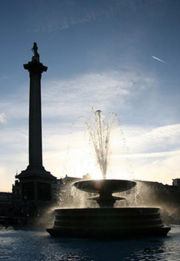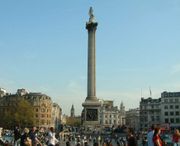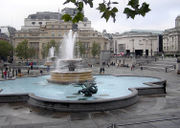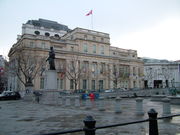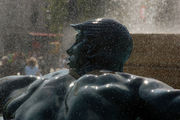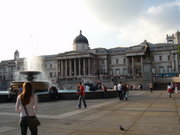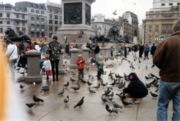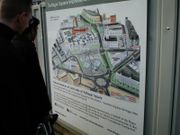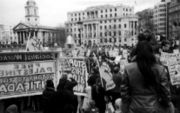Trafalgar Square
2007 Schools Wikipedia Selection. Related subjects: Geography of Great Britain
Trafalgar Square is a square in central London that commemorates the Battle of Trafalgar ( 1805), a British naval victory of the Napoleonic Wars. The original name was to have been "King William the Fourth's Square", but George Ledwell Taylor suggested the name "Trafalgar Square". Its coordinates are .
The northern area of the square had been the site of the King's Mews since the time of Edward I, while the southern end was the original Charing Cross, where the Strand from the City met Whitehall, coming north from Westminster. As the midpoint between these twin cities, Charing Cross is to this day considered the heart of London, from which all distances are measured.
In the 1820s the Prince Regent engaged the landscape architect John Nash to redevelop the area. Nash cleared the square as part of his Charing Cross Improvement Scheme. The present architecture of the square is due to Sir Charles Barry and was completed in 1845.
The square, a popular site for political demonstrations, is the site of Nelson's Column, and related sculptures of note.
Overview
The square consist of a large central area surrounded by roadways on three sides, and stairs leading to the National Gallery on the other. The roads which cross the square form part of the busy A4 road, and prior to 2003, the square was surrounded by a one-way traffic system on all sides. Underpasses attached to Charing Cross tube station still allow pedestrians to avoid traffic. Recent works have reduced the width of the roads and closed the northern side of the square to traffic.
Nelson's Column is in the centre of the square, surrounded by fountains designed by Sir Edwin Lutyens in 1939 and four huge bronze lions sculpted by Sir Edwin Landseer; the metal used is said to have been recycled from the cannon of the French fleet. The column is topped by a statue of Lord Nelson, the admiral who commanded the British Fleet at Trafalgar.
On the north side of the square is the National Gallery and to its east the St Martin's-in-the-Fields church. The square adjoins The Mall via Admiralty Arch to the southwest. To the south is Whitehall, to the east Strand and South Africa House, to the north Charing Cross Road and on the west side is Canada House.
At the corners of the square are four plinths; the two northern ones were intended to be used for equestrian statues, and thus are wider than the two southern. Three of them hold statues: George IV (northeast, 1840s), Henry Havelock (southeast, 1861, by William Behnes), and Sir Charles James Napier (southwest, 1855). Mayor of London Ken Livingstone controversially expressed a desire to see the two generals replaced with statues that "ordinary Londoners would know".
On the lawn in front of the National Gallery are two statues, James II to the west of the entrance portico and George Washington to the east. The latter statue, a gift from the state of Virginia, stands on soil that was imported from the United States. This was done in order to honour Washington's declaration that he would never again set foot on British soil.
In 1888 the statue of General Charles George Gordon was erected. In 1943 the statue was removed and, in 1953, re-sited on the Victoria Embankment.
The Square has become an enormously important symbolic social and political location for visitors and Londoners alike, developing over its history from "an esplanade peopled with figures of national heroes, into the country’s foremost place politique," as historian Rodney Mace has written. Its symbolic importance was demonstrated in 1940 when the Nazi SS developed secret plans to transfer Nelson's Column to Berlin following an expected German invasion, as related by Norman Longmate in If Britain Had Fallen ( 1972).
The fourth plinth
The fourth plinth on the northwest corner was intended to hold a statue of William IV, but remained empty due to insufficient funds. Later, agreement could not be reached over which monarch or military hero to place there.
In 1999, the Royal Society of Arts conceived the idea of the Fourth Plinth Project, which temporarily occupied the plinth with a succession of works commissioned from three contemporary artists. These were:
- Ecce Homo, by Mark Wallinger ( 1999)
- Regardless of History, by Bill Woodrow ( 2000)
- Monument, by Rachel Whiteread ( 2001)
Wallinger's Ecce Homo — whose title, in Latin, means "behold the man", a Biblical reference — was of a life-sized man. Atop the huge plinth, designed for larger-than-life statuary, it looked minuscule. Some commentators said that, far from making the man look insignificant, his apparent tininess drew the eye powerfully; they interpreted it as a commentary on human delusions of grandeur.
Whiteread's Monument, by an artist already notable for her controversial Turner Prize-winning work "House" and the Judenplatz Holocaust Memorial in Vienna, was a cast of the plinth in transparent resin, and placed upside-down on top of the original. Following the exhibition project, some wished to see it continue in this role.
Various companies have used the plinth (often without permission) as a platform for publicity stunts, including a model of David Beckham by Madame Tussauds. The London-based American harmonica player Larry Adler jokingly suggested erecting a statue of Moby Dick, which would then be called the " Plinth of Whales".
The best use of the fourth plinth remains the subject of debate. On March 24, 2003 an appeal was launched by Wendy Woods, the widow of the anti- apartheid journalist Donald Woods, hoping to raise £400,000 to pay for a nine- foot high statue of Nelson Mandela by Ian Walters. The relevance of the location is that South Africa House, the South African high commission, scene of many anti-apartheid demonstrations, is also located on Trafalgar Square.
A committee convened to consider the RSA's late- 1990s project concluded that it had been a success and "unanimously recommended that the plinth should continue to be used for an ongoing series of temporary works of art commissioned from leading national and international artists" . After several years in which the plinth stood empty, the new Greater London Authority assumed responsibility for the fourth plinth and started its own series of temporary exhibitions:
- Marc Quinn: Alison Lapper Pregnant ( September 15, 2005)
- Thomas Schutte: Hotel for the Birds (scheduled for April 2007)
Quinn's Alison Lapper Pregnant is a 3.6m marble torso- bust of Alison Lapper, an artist who was born with no arms and shortened legs due to a condition called phocomelia.
A television ident for the television station Channel 4 shows a CGI Channel 4 logo on top of the fourth plinth.
Pigeons
The square is a popular tourist spot in London, and used to be particularly famous for its pigeons (Rock Pigeons). Feeding the pigeons was a popular activity with Londoners and tourists. The National Portrait Gallery displays a 1948 photograph of Elizabeth Taylor posing there with bird seed so as to be mobbed by birds. The desirability of the birds' presence has long been contentious: their droppings look ugly on buildings and damage the stonework, and the flock, estimated at its peak to be 35,000, was considered to be a health hazard. In 1996, police arrested one man who was estimated to have trapped 1500 birds for sale to a middleman; it is assumed that the birds ended up in the human food chain.
In 2000, the sale of bird seed in the square was controversially terminated and other measures were introduced to discourage the pigeons, including the use of trained falcons. Supporters of the pigeons and some tourists continued to feed the birds, but, in 2003, Ken Livingstone enacted by-laws to ban the feeding of pigeons within the square . There are now relatively few birds in Trafalgar Square and it is used for festivals and hired out to film companies, in a way that was not feasible in the 1990s.

Redevelopment
In 2003 the redevelopment of the north side of the square was completed. The work involved demolishing part of the wall and building a wide set of stairs. This construction includes two Saxon scissor lifts for disabled access, public toilets, and a small café. Plans for a large staircase had long been discussed, even in original plans for the square. The new stairs lead to a large terrace or piazza in front of the National Gallery, in what was previously a road. Previously access between the square and the Gallery was via two busy crossings at the north east and north west corners of the square. The pedestrianisation plan was carried out in the face of protests from both road-users and pedestrians concerned that the diversion of traffic would lead to greater congestion elsewhere in London. However, this does not seem to have happened; the reduction in traffic due to the London congestion charge may be a factor.
Christmas ceremony
There has been a Christmas ceremony every year since 1947. A Norway Spruce (or sometimes a fir) is given by Norway's capital Oslo and presented as London's Christmas tree, as a token of gratitude for Britain's support during World War II. (Besides the general war support, Norway's then King Haakon and his son Crown Prince Olav, as well as the country's government, lived in exile in London throughout the war.) As part of the tradition, the Lord Mayor of Westminster visits Oslo in the late autumn to take part in the chopping down of the tree, and the Mayor of Oslo then goes to London to light the tree at the Christmas ceremony.
Political demonstrations
Since its construction, Trafalgar Square has been a venue for political demonstrations, though the authorities have often attempted to ban them.
By March of the year Nelson's column opened, the authorities had started banning Chartist meetings in the square. A general ban on political rallies remained in effect until the 1880s, when the emerging Labour movement, particularly the Social Democratic Federation, began holding protests there.
On " Black Monday" ( 8 February 1886), protesters rallied against unemployment; this led to a riot in Pall Mall. A larger riot (called "Bloody Sunday") occurred in the square on 13 November 1887.
One of the first significant demonstrations of the modern era was held in the square on 19 September 1961 by the Committee of 100, which included the philosopher Bertrand Russell. The protesters rallied for peace and against war and nuclear weapons.
Throughout the 1980s, a continuous anti-apartheid protest was held outside of South Africa House. More recently, the square has hosted the Poll Tax Riots ( 1990) and anti-war demonstrations opposing the Afghanistan war and the Iraq war.
The Square was also scene to a large vigil held shortly after the terrorist bombings in London on Thursday 7 July 2005.
Sports events
In recent years Trafalgar Square has become the location to the climax for victory parades for the England national rugby union team in the 2003 Rugby World Cup on the 9th December 2003 and on the 13th September 2005 was also the climax of the victory parade for the England national cricket team victory against the Australia national cricket team in The Ashes.
In 6 July 2005 Trafalgar Square was a gathering place for many London citizens to hear the announcement that they will host the 2012 Summer Olympics.
VE Day celebrations
Victory in Europe Day (V-E Day or VE Day) was May 8, 1945, the date when the Allies during the Second World War formally celebrated the defeat of Nazi Germany and the end of Adolf Hitler's Third Reich.
Trafalgar Square was filled with British subjects wanting to hear the formal announcement by Sir Winston Churchill that the war was over: it was packed to bursting point. Trafalgar Square was used as a place of celebration and people from all over the country came there. A diary extract told how a father took his three children and wife to Trafalgar Square, and they all held on to a piece of washing line so they didn't get lost in the massive crowd.
On Sunday 8 May 2005 the BBC held a concert to celebrate the 60th anniversary of VE Day which was hosted by Eamonn Holmes and Natasha Kaplinsky. Many people who lived during the war attended, and many of the much younger generation, but most importantly many old veterans came and told the stories of their hardships during the six years of war.
New Year events
For many years, revellers celebrating the start of a New Year have gathered on the square, despite a lack of civic celebrations being arranged for them. The lack of official events in the square was partly because the authorities were concerned that actively encouraging more partygoers would cause overcrowding.
Hogmany at Edinburgh, Scotland has instead been the focus for British New Year celebrations, although in recent years, a firework display from the London Eye and the banks of the Thames, near the square, has given spectators a fitting start to the New Year.
Access
Nearest London Underground stations:
- Charing Cross ( Northern, Bakerloo lines) — has an exit in the square
- Embankment ( District, Circle lines)
- Leicester Square (Northern, Piccadilly lines)
Other Trafalgar Squares
National Heroes Square in Bridgetown, Barbados was originally named Trafalgar Square in 1813, before the better known British throughfare, with another statute of Admiral Horatio Nelson featured. The name change occurred on April 28, 1999.
